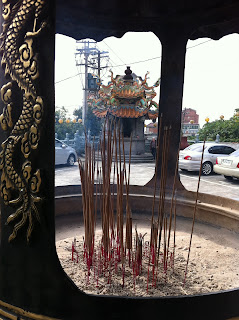When the Portuguese saw the island of Taiwan in 1544, they named it "Ilha Formosa," or "Beautiful Island." Yesterday, my uncle took me and my cousin to several tourist spots to see the many and different beautiful things Taiwan has.
Our first stop was Yehliu Geopark which is a coastline filled with geological landscapes. Admission to the park is NT50, or less than $2 USD. The park is most famous for the Queens Head, so named because it is shaped like Nefertiti's head. The geological landscape was formed due to sea erosion, which continues to this day. This means that through the years, the neck of the Queens Head has become thinner and the park rangers are worried that in a few years, the Queens Head may break off. I am definitely glad I was given the opportunity to see the real thing before that happens!
Due to the fragility of the Queen's Head, the park made a replica of the head that is near the entrance of the park. Here is my uncle and cousin with the replica, along with the entrance sign and a sign explaining the Queen's Head.
Here we are with the actual Queen's Head. Unfortunately, due to the time of the year, there were just way too many people around so I could never get just a shot of the Queen's Head. When my brother and my dad went last year, they were able to get great photos of the Queen's Head without anyone in the background. C'est la vie.
Here's the line JUST to take a picture with the Queen's Head. Ridiculous.
Us with other interesting rock formations.
After Yehliu, my uncle then drove us to San Zhi, which is famous for its water wheels. One of the most impressive is one made entirely of wood and uses the water from the nearby river.
Near San Zhi is one of the most interesting things I have ever seen. There is a temple not too far up the mountain that is almost entirely covered with seashells. In Mandarin, it is called "Pei Khe Miao." Pei Khe being seashell and Miao being temple. So literally, Seashell Temple. It is customary for people during the first 15 days of the new year to go to the temples nearly every day to pray. Usually, temples, even the Seashell Temple is relatively empty, save for a few devout worshipers. We probably chose one of the worst times of the year to visit a temple. The amount of people there was simply incredible, and we had to park maybe a quarter of the mile away. The main hall of the temple is like any other Buddhist temple in terms of layout. However, this particular temple also has a small tunnel that goes through the back and is filled with smaller deities, wishing ponds and of course, seashells.
In all the times I come back to Taiwan (which is quite a lot, considering I come back every 1-2 years), I had never been to the above places. It was so interesting to see all the amazing things Taiwan has to offer. I can't wait for my next trip back so I can visit other spots!
Upon returning home, we had some birthday cake for my cousin, who turned 9 yesterday. He was so happy to have been able to go out with us that he barely slept the night before. Generally, kids in Taiwan are in school 90% of the time. Even though classes end at a reasonable time, most end up going to "bu xi ban," or extra study hall. These can last until 8 or 9pm at night, so for him to have the opportunity to go out and play was a rarity.
After a much needed nap and some dinner, I went with my cousins to the world famous ShiLin night market. I had been to the night market on several occasions, but I had never seen it this full of people. The night market is several alleyways that are filled with shops and moveable carts, so it's not one big open space. I literally felt like I was being herded through. CNY is probably the worst time to go, as it is full of locals, Taiwan tourists from the middle and south, and other tourists. My cousins and I thought we were being smart by getting there at 7:30pm (usually the later it is, the more crowded it gets). Even then, we had to wait half an hour to park our car in the lot!
The night market is most famous for its inexpensive products - clothes, jewelry, shoes, you name it. It is also famous for the food. Taiwanese culture revolves around food, and the night market does not disappoint. Within a few blocks of the night market, you can already begin to smell the assortment of good eats the night market has to offer. Perhaps the most distinctive smell is stinky tofu - which, in my opinion, smells quite good :) You kind of just get used to it. There are also stands that sell milk tea, something called frog jelly tea, chicken cutlets, hot cakes, chinese sausages, oyster pancakes, you name it, the night market probably has it. Actually I take that back, I've never seen pizza at the night market.
pictures of stinky tofu, cold noodles, hot cakes, lanterns, and the crowd:
After buying the few things I needed and getting some stinky tofu, we decided it was time to escape the crowd and head home.



















